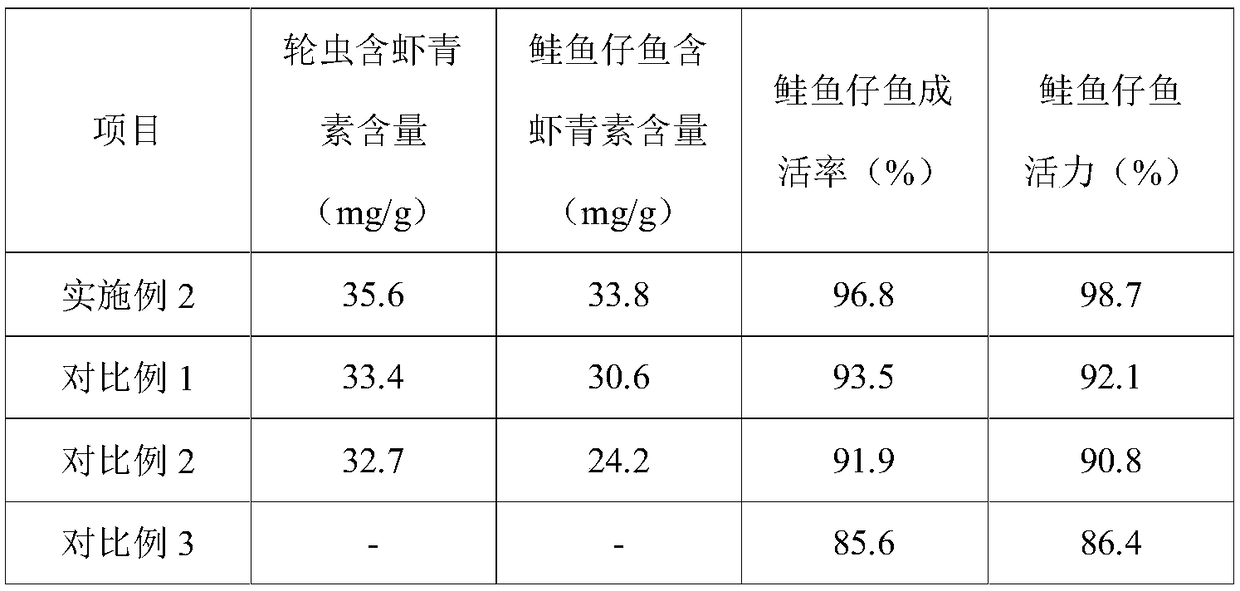Culture method of seaweed for zooplankton bait
A zooplankton and culture method technology, applied in the field of seaweed culture, can solve the problems of unfavorable absorption by aquaculture animals, insufficient stability of astaxanthin structure, and low degree of esterification, so as to enhance the body's immunity, shorten the time of synthesis and accumulation Cycle, low cost effect
- Summary
- Abstract
- Description
- Claims
- Application Information
AI Technical Summary
Problems solved by technology
Method used
Image
Examples
Embodiment 1
[0028] A method for cultivating Haematococcus pluvialis, specifically comprising the following steps:
[0029](1) Pretreatment of domestic sewage: standing for sedimentation, impurities and large particles in the sedimentation water; adding fruit peels to the filtered clarified liquid, first stirring for 5 minutes, then standing for 20 minutes; then filtering through a 25 micron membrane filter; filtering the filtered water Samples were sterilized by heating and boiling at 120°C for 20 minutes;
[0030] Above-mentioned pericarp is processed as follows: take the pericarp of pomelo, pomegranate, banana, mangosteen fruit, and this pericarp is the pericarp of growing green period; Take fresh pericarp, scrape off the wax on the surface with a knife, and then immerse in a temperature of 30 ℃. After soaking in 1.5M sodium polyacrylate solution for 15 minutes, wash it twice with 2M ethyl acetate solution and dry it in the air; the pores on the surface of the peel treated with sodium p...
Embodiment 2
[0034] A method for cultivating Haematococcus pluvialis, specifically comprising the following steps:
[0035] (1) Pretreatment of domestic sewage: standing for sedimentation, impurities and large particles in the sedimentation water; adding fruit peels to the filtered clarified liquid, first stirring for 8 minutes, then standing for 25 minutes; then filtering through a 20 micron filter membrane; filtering the filtered water The sample is sterilized by autoclaving: the sterilization temperature is 115°C, the sterilization pressure is 0.08MPa, and the sterilization time is 18min;
[0036] Above-mentioned pericarp is processed as follows: take the pericarp of pomelo, pomegranate, banana, mangosteen fruit, and this pericarp is the pericarp of growing green period; Get fresh pericarp, scrape off the wax on the surface with a knife, then immerse in a temperature of 33 ℃. Soak in 2.5M sodium polyacrylate solution for 20 minutes, wash with 2M ethyl acetate solution for 3 times, and d...
Embodiment 3
[0040] Utilize the obtained Haematococcus pluvialis cultured in Example 2 of the present invention to carry out zooplankton (rotifer) cultivation, rotifers are inoculated with a density of 20 / ml in the filtered pond water, and the rotifer culture solution is grown at 26° C. Keep ventilated down, and feed the gained Haematococcus pluvialis (living cell) that the present invention cultivates, cultivate 7 days, can make the density proliferation of rotifers to 2300 / ml. Microalgae can also be fed with other baits; the amount of feeding is adjusted according to the density of zooplankton.
PUM
 Login to View More
Login to View More Abstract
Description
Claims
Application Information
 Login to View More
Login to View More - R&D
- Intellectual Property
- Life Sciences
- Materials
- Tech Scout
- Unparalleled Data Quality
- Higher Quality Content
- 60% Fewer Hallucinations
Browse by: Latest US Patents, China's latest patents, Technical Efficacy Thesaurus, Application Domain, Technology Topic, Popular Technical Reports.
© 2025 PatSnap. All rights reserved.Legal|Privacy policy|Modern Slavery Act Transparency Statement|Sitemap|About US| Contact US: help@patsnap.com

